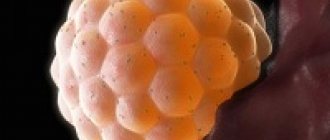During pregnancy, a woman's body undergoes amazing changes. However, even greater changes occur with the fetus, which in 9 months goes through the development path from one cell to a fully formed human body. Intrauterine formation occurs very quickly, every week new organs are formed in the fetus, its body develops, and by the 40th week it becomes ready for life outside the mother’s body. What kind of metamorphoses happen to the baby and mother every week of pregnancy?
Periods of pregnancy (generally accepted classification)
The entire course of pregnancy is divided into three parts, which are called trimesters:
- from 1 day to 14 weeks;
- 14–26 weeks;
- from 27 weeks to birth.
It is generally accepted that pregnancy lasts 9 months.
However, it is more accurate to calculate the due date using the Naegele method, according to which a woman carries a child for 40 weeks, or 280 days (more details in the article: how is the due date determined using the Naegele formula?). There are other gradations by which pregnancy is divided into stages. Until the 10th week, the process of forming a new life in the expectant mother’s tummy is called embryogenesis, and the baby inside her is at a stage called an embryo. From the 10th week it is called a fetus (see also: what happens to the baby and mother at the 10th obstetric week of pregnancy?).
The entire course of pregnancy is called prenatal development, and from 22–23 weeks the prenatal, or prenatal, stage begins (see also: 21–22 weeks of pregnancy: what happens to the baby and mother?). From this stage, the child becomes viable; he can survive outside the mother’s body.
It is customary to count pregnancy by weeks. There are two ways, according to the first, the counting starts from the moment of fertilization. The second method is called obstetric, and the starting date is the beginning of the last menstruation. The difference between these two counting systems is 2–3 weeks.
Many people start keeping a diary or pregnancy calendar. Sometimes doctors advise doing this to make it easier to track how pregnancy is progressing and to notice changes in sensations.
A little theory
Introduction of fertilized egg into the uterus
called implantation. The embryonic villi penetrate the lining of the uterus, which may cause minor bleeding.
In order for implantation to be successful, several conditions must be met:
- lush three-layer endometrium with a high content of substances that nourish the embryo;
- high amount of progesterone in the body (so that the embryo can develop and menstruation does not begin);
- normal microflora in the body.
The process of fertilization and development of the fertilized egg is not a one-step process. And each stage is important for the onset of a normal pregnancy and the formation of a healthy fetus.
Conception and development of the embryo and the sensations of a woman in the first trimester
Pregnancy begins with conception. If sexual intercourse occurs at the time of ovulation or within 1–2 days after it, the sperm enter the uterus and are directed into the fallopian tubes. They are able to remain active for 48–72 hours, so when ovulation is delayed due to a missed cycle, fertilization will still occur. The fusion of the egg and sperm occurs in the fallopian tubes. When they merge, they form a zygote - this is how a new life begins. How is intrauterine development of the fetus progressing week by week?
From 1st to 4th week (first month)
In the first months of pregnancy, the human embryo develops rapidly. Every day is marked by new formations.
In the first 4 days, while the zygote is still in the fallopian tube, crushing begins. The zygote, which is one cell, is divided into two, which, in turn, are also divided in half - and so on. During this process, the embryo does not increase in size; each new cell is half the size of the mother cell. After 4 days, the embryo consists of 10–20 cells and its size is 0.14 mm.
On day 5, the blastocyst—that’s what the embryo is now called—emerges into the uterus and attaches to the endometrium on days 7–8. The woman feels a pull in her lower abdomen, and bloody brown marks appear on her underwear.
When the embryo is implanted into the endometrium, it begins to produce human chorionic gonadotropin, which triggers changes in the body of the expectant mother. It is because of this substance that a pregnancy test shows two lines.
How does the embryo develop at 3–4 weeks? At this stage, the embryo begins to form organs:
- the neural tube runs along the entire length of the human embryo, from which the brain and spinal cord will soon form;
- on day 21 the heart beats;
- blood circulates;
- eye sockets and vesicles are formed from which eyes will develop;
- the rudiments of limbs appear;
- the liver, kidneys, and gastrointestinal tract are formed.
The expectant mother begins to notice characteristic sensations during pregnancy. She feels weak, dizzy, nauseous and vomiting. The temperature stays at 37°C, and my mood constantly changes. This is normal in the second month of pregnancy. How long do these symptoms last? For some mothers, until mid-term or even longer.
From 5th to 8th (second month)
By week 7, the embryo is 2.3 cm long and weighs 2 g. It begins to move inside the mother, but she does not yet notice it.
The table contains a description of the development of embryonic organs by week:
| weeks | Emerging organs | Changes taking place |
| 5 | Paddle -shaped hands | Sex glands and cells are formed |
| 6 | Facial features, nose, eyes, jaws | The iris appears in the eyes and the retina forms Limbs bend The intestine lengthens, due to lack of space in the abdominal cavity, it extends into the umbilical cord |
| 7 | Placenta Four-chambered heart and great vessels | Endocrine glands develop Fingers have formed Testes and ovaries begin to develop |
| 8 | Genital tubercle, urogenital and anal membrane | The Y chromosome (if present) produces testosterone, which produces male sexual characteristics. The kidneys produce urine. |
A mucus plug appears in the cervix, covering the cervical canal (more details in the article: what is a mucus plug during pregnancy?). It protects the baby from getting infection inside.
At the beginning of the second month, the expectant mother is required to visit a gynecologist. He prescribes an ultrasound, which can detect early abnormalities in the development of the embryo. In case of severe pathologies, medical abortion is prescribed; at such early stages it is still permitted.
From the ninth to the 13th week (third month)
The baby has gone through all stages of embryonic development and is now called a fetus. Many of his organs have practically formed:
- oral cavity and tooth buds;
- cerebral hemispheres;
- intestines;
- thyroid;
- pancreas;
- gallbladder;
- bile ducts.
In ultrasound images, you can see the sex of the unborn baby when he is turned towards the device: in girls, the clitoris appears, and in boys, the penis appears. The anus is formed. Below you can see a photo of the ultrasound, which shows the floor.
Agglutinogens appear in the fetal blood, making it possible to determine the blood type and Rh factor. Lymphocytes differentiate in the thymus gland, and leukocytes are formed in the bone marrow.
Significant hormonal changes occur in the mother's body. Nausea and weakness gradually go away, although in some pregnant women signs of toxicosis persist until delivery. Body temperature normalizes, mood swings become less severe.
The uterus increases in size, by the end of the first trimester it is already the size of a fist. The organ gradually moves into the abdominal cavity. Fetal weight 23 g, height – 7.5 cm.
Sufficient progesterone levels
Progesterone is a pregnancy hormone that is produced in the ovaries and is involved in determining the stages of embryo development after implantation.
Progesterone affects the growth of the uterus, as well as fetal tissue. That is why determining progesterone is an important step in successful IVF.
Before pregnancy, progesterone levels are as follows:
- follicular phase – up to 2.3 nmol/l;
- ovulatory phase – up to 9.4 nmol/l;
- luteal phase – up to 56 nmol/l.
When performing IVF and at the time of embryo transfer, progesterone should be up to 460 nmol/l.
What happens to the fetus and mother in the second trimester?
Many women call the second trimester the calmest period of pregnancy. Toxicosis is already behind us, the stomach is gradually starting to grow, but is still small enough to cause discomfort. The fetus continues to develop rapidly, it quickly gains weight and grows. By the end of the second trimester, almost all of the baby’s organs are formed.
How does fetal development occur at 4–6 months?
From the 14th to the 17th week (fourth month)
At the 4th month, the fetus looks like a little man. His skin has fully formed, but it is still too thin and transparent, so blood vessels can be seen through it. Sweat and salivary glands begin to form. You can see what a child looks like during this period in the photo.
The baby puts his finger in his mouth and grimaces, because the facial muscles are already developed. This indicates the formation of the musculoskeletal system. Some women, especially those for whom this is a repeat pregnancy, feel the baby's movements.
During this period, at week 16, it may be necessary to perform amniocentesis - sampling of amniotic fluid for further analysis, which can reveal abnormalities in the development of the fetus.
The internal organs of the fetus began to work:
- the liver secretes bile;
- pancreas – insulin;
- bone marrow - red blood cells;
- the heart pumps about 600 ml of blood per day.
Under the influence of hormones, the pigmentation of a pregnant woman's body changes. The skin of the areolas darkens, a dark line is noticeable on the stomach. Thin women have a noticeable belly. By the end of 4 months, the fetus weighs 140 g, its height is 13 cm.
From the 18th to the 21st week (fifth month)
It is during this time period that you need to undergo the next scheduled ultrasound. At week 18, the hearing aid and the area of the brain responsible for hearing completes its formation. It is important for mom to talk to her child, because he hears her voice. The areas of the brain responsible for perceiving signals from receptors and analyzers have already been formed; they are only being improved before birth.
The fruit distinguishes between day and night. He prefers to move at certain times and sleep the rest of the time. If there are twins in the mother's tummy, the babies feel each other and hold hands. When moving and feeling the amniotic sac, the fetus uses the leading hand - right or left.
The baby swallows amniotic water. From it he receives liquid and nutrients. The remains are excreted by the kidneys in the urine, carbohydrates are absorbed in the intestines, and undigested particles accumulate inside in the form of meconium, which will be released in the first two days after birth. At 21 weeks he weighs 300 g, his height is 16 cm (we recommend reading: description of the 21st week of pregnancy: how many months is it, what happens to the mother and baby?).
In the fifth month, significant changes occur in a woman’s body. Blood volume increases by almost 0.5 liters, heart rate increases, and hemoglobin decreases. The mother may develop anemia. The enlarging uterus puts pressure on the intestines and bladder - problems with bowel movements and urination begin.
From the 22nd to the 26th week (sixth month)
Almost all of the child’s organs are formed and continue to improve:
- the alveoli of the lungs produce surfactant, which prevents them from sticking together during breathing;
- the testicles descend from the abdominal cavity downwards, in girls a vagina is formed;
- tooth germs are covered with dentin and enamel;
- the vestibular apparatus allows the fetus to determine its own position;
- the fetus may blink;
- the spinal column has 33 vertebrae and supports the torso;
- a papillary pattern appears on the fingertips;
- The pituitary gland produces adrenocorticotropic hormone, which affects the adrenal glands, which, in turn, begin to produce glucocorticoids.
At the 6th month, active formation of the musculoskeletal system and dental structure occurs, so the mother should eat calcium-containing foods. The fetus has filled the entire space where it is located and begins to push apart the walls of the uterus; it weighs about 700 g. At this time, the woman feels cramping attacks - Braxton-Hicks contractions. There is no need to worry, the contraction of the uterine muscles does not threaten the baby, but prepares the organ for the upcoming birth.
Under the influence of placental lactogen, the expectant mother's mammary glands enlarge and colostrum begins to appear in them. Some women notice an increase in their breasts by 1-2 sizes.
Do taste preferences change?
During pregnancy, taste preferences change: for example, if a woman loved sweets, she may completely stop loving them and greedily eat spicy, salty, etc. At the same time, the consumption of spicy and salty foods should be reduced to avoid swelling.
It is quite important to be under the supervision of an obstetrician-gynecologist from the first trimester. It is necessary to contact either an antenatal clinic at your place of residence or a paid medical institution that provides pregnancy services.
Third trimester: baby's growth and mother's preparation for childbirth
With the onset of the third trimester, there are only a few weeks left before giving birth. If the baby is born prematurely, he will already be able to survive outside the womb.
During this period, the abdomen rapidly increases in size. Women note a deterioration in their health, pain due to displacement of internal organs. Many people start taking special courses to prepare for childbirth. What can be said about the course of prenatal development at this stage?
From the 27th to the 30th week (seventh month)
The fetus grows very quickly, at week 29 it weighs 1150 g and its height is 37 cm. The uterus increases in size, displacing and squeezing the internal organs. In the seventh month of pregnancy, it is important for a woman to monitor her health, because such changes in her body can lead to complications.
The table provides information about the increase in the size of the uterus and the consequences for women:
| weeks | Position of the uterus | Complications | Prevention of complications |
| 27–28 | 28 cm above the womb | The uterus puts pressure on the diaphragm, making breathing difficult. Due to the additional severity, varicose veins are possible. The blood is tested for Rh factor. | Walking in the fresh air, resting on your side or in a position that promotes blood flow from the legs. To prevent Rh conflict, anti-Rhesus immunoglobulin is administered. |
| 29–30 | 30 cm above the womb | Possible preeclampsia, high blood pressure, protein in the urine, inferior vena cava syndrome due to its compression by the uterus (characterized by fainting). | Control of weight gain, preventing its strong increase. Rest lying on your side. |
What changes happen to the baby (more details in the article: what happens to the baby at 27 weeks of pregnancy?)? He gets hair on his head. He often sucks his thumb in his sleep and even smiles. If the baby is born at the end of the seventh month, he will be able to survive even without artificial ventilation.
From the 31st to the 35th week (eighth month)
The baby is fully formed, but if he is born at 8 months, he will still need help. The immune system has not fully formed, the nervous system continues to develop, and the baby accumulates subcutaneous fat for thermoregulation.
The fruit is growing rapidly. If at 31 weeks his weight and height average 2 kg and 40 cm, then at 35 he grows to 2.4 kg and 46 cm.
By the end of the 8th month, the uterus reaches its maximum size. Some women have abdominal volume exceeding 100 cm. A pregnant woman complains of feeling unwell. She suffers from insomnia, shortness of breath, heartburn, and stomach pain. Digestion worsens, the expectant mother feels nauseous, and suffers from constipation and hemorrhoids. You can see what pregnancy looks like at 35 weeks in the photo.
From the 36th to the 40th week (ninth month)
There is a suspension of intrauterine development of the fetus during this period, because, starting from the 36th week, the child is considered fully full-term and ready for birth. Usually the baby is born at 39–40 weeks (see also: precursors of labor at 39 weeks of pregnancy). If by the middle of the 9th month of pregnancy the precursors of labor have not appeared, you should not induce them artificially: the longer the child stays in the womb within the normal gestation period, the better.
The baby takes a position convenient for passing through the birth canal - head down. Sometimes the fetus is positioned with the pelvis towards the cervix or back, this is observed during an ultrasound. If a natural birth is possible with a breech presentation, a cesarean section is prescribed for a lateral birth. There is no need to worry if at 36 weeks the baby has not yet turned head down, he has almost a month to do this.
What sensations does a woman experience in the ninth month of pregnancy? The woman feels better. This is explained by the fact that the baby calms down and no longer puts pressure on the internal organs. Nagging pain in the lower back and rare contractions indicate that the moment of delivery is already close.
A couple of days before childbirth (sometimes just before it), the mucous plug that was covering the cervical canal comes off. A woman notices red-brown discharge on her underwear. As soon as the contractions become regular and frequent, the water breaks, the woman in labor should go to the hospital. For multiparous mothers, sometimes there is so little time between the first signs of labor and delivery that they give birth at home or in an ambulance.
Embryo implantation: timing
As a rule, embryo implantation occurs 7-10 days after fertilization, including the period of ovulation. The attachment process itself lasts 40 hours, followed by a period of embryo development. It is believed that implantation occurs until the placenta is formed, protecting the fetus. This period lasts until 20 weeks of pregnancy.
There are early and late implantation. Early implantation is quite rare. It occurs 6-7 days after ovulation. Despite the fact that the uterus is not yet ready for the attachment of the embryo, the process of implantation itself is possible, and accordingly, pregnancy occurs.
Late embryo implantation occurs on the 10th day after fertilization. This type of implantation is favorable for in vitro fertilization.
Does pregnancy always last 40 weeks?
What to do if the 40th week is coming to an end, and there are no signs of impending labor? The expectant mother should not worry, this is a normal course of pregnancy, since it is impossible to calculate the absolutely exact date of conception and birth. Babies are usually born between 38 and 40 weeks, but these are just averages. Childbirth at 41–42 weeks is not considered a pathology.
If, after this period, there is no prenatal activity, doctors stimulate contractions with medications. A baby born after 43 weeks is considered post-term. The cause of post-term pregnancy may be endocrine pathologies in the mother or fetus.
Premature birth is much more dangerous for the baby than late birth. A newborn born before 37 weeks is considered premature. Causes of premature birth:
- difficult living and working conditions for women;
- gynecological pathologies;
- hormonal disorders;
- infectious infections during pregnancy;
- abdominal injuries;
- genetic abnormalities of the fetus.
The table provides information on the survival rate of children born prematurely:
| A week | 22 | 23 | 24 | 25 | 26 | 27 | 30 | 34 | |
| Chance of survival, % | 0 | 0–10 | 10–35 | 40–70 | 50–80 | 80–90 | 90 | 95 | 98 |
| Weight, g | 360 | 400 | 500 | 600 | 700 | 850 | 1000 | 1200 | 2100 |
Any prematurity negatively affects the baby. The earlier the baby is born, the greater the chance that he will have some kind of developmental pathology. The results of long-term studies show that many children born at 6 months had moderate and severe disabilities, vision and hearing problems, and mental retardation.
Embryo implantation after in vitro fertilization
Today, a considerable number of couples are faced with the impossibility of conceiving a child naturally. The reason for this may be factors of both female and male infertility, as well as infertility of unknown origin, in which a comprehensive examination of partners does not reveal any visible reasons for making such a diagnosis.
In cases where there is a combination of several factors of infertility or unsuccessful use of standard treatment methods, couples decide to undergo in vitro fertilization. Specialists will conduct all the necessary examinations of both partners and select a program for preparing and carrying out the procedure, taking into account the individual characteristics of each couple.










